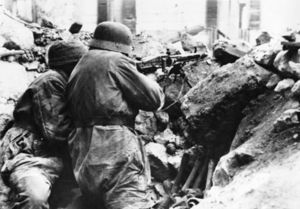Battle of Bloody Gulch
| Battle of Bloody Gulch | |||||||
|---|---|---|---|---|---|---|---|
| Part of 10 Days War | |||||||
A machine gun crew of the Verteidigungsstaffel fires their MG-12 at entrenched Porantan soldiers during the battle |
|||||||
|
|||||||
| Belligerents | |||||||
| Porant | |||||||
| Commanders and leaders | |||||||
| Unknown | ||||||
| Units involved | |||||||
| Infantry Regiment | ||||||
| Strength | |||||||
| 38,181 soldiers 200 tanks | 2,500 soldiers
20 tanks |
||||||
| Casualties and losses | |||||||
| Dead: 23 | Dead: Over 900 |
||||||
The Battle of Bloody Gulch was an engagement between military forces of Porant and Rotgeheim that took place on 20 January, 1913, in the small town of Auerbach, Hundermenschen. This engagement was the first contact between Porant and Rotgeheim in the 10 Days War and resulted out of a surprise confrontation between the opposing forces. It lasted from 8:14 a.m. to roughly 4:00 p.m., when the 5th VS-Panzer Division under the command of Lieutenant General-VS Walter Karl Ulrich took control of the town.
Background
This battle was the first in a series of engagements between the militaries of Rotgeheim and Porant. Rotgeheim arrived in Hundermenschen with the 1st VS-Panzer Army of the Verteidigungsstaffel (which was not the formal military, rather, it was a paramilitary quick-reaction force) in response to the Poratan invasion of the country. Rotgeheim sent roughly 300,000 troops of the Verteidigungsstaffel to counter the threat that Porant posed. The II VS-Panzerkorps - comprised of the 1st VS-Panzer Division Kaiser Florian von Horn, 5th VS-Panzer Division Wiking, 11th VS-Panzergrenadier Division Selbstständigkeit, and 16th VS-Panzer Division Sturm - was the first Rotgeheiman formation to land and head off toward its ultimate goal of eliminating the Porantan invaders. It was expected that the Porantan military would have a defensive perimeter about 20 km around the beachhead, but in reality the perimeter stretched 50 km around. Auerbach was just inside this 50 km-long defensive line.

